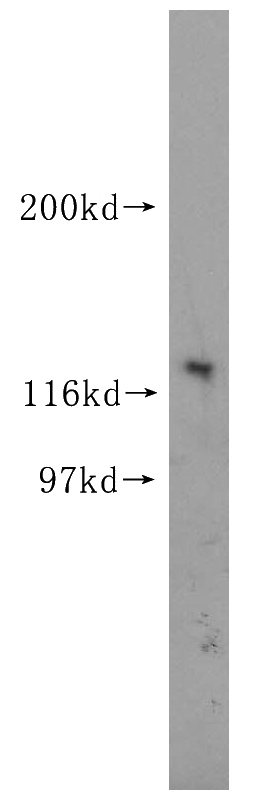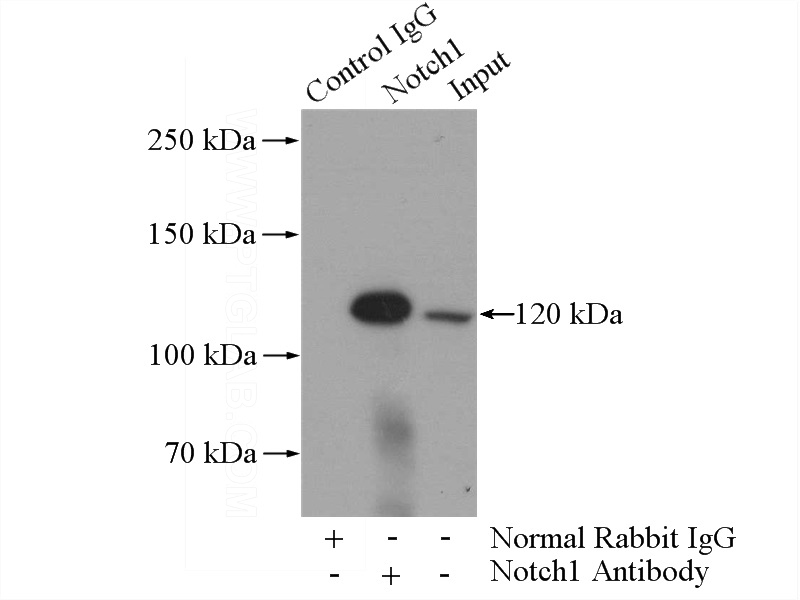-
Product Name
Notch1 antibody
- Documents
-
Description
Notch1 Rabbit Polyclonal antibody. Positive IP detected in HeLa cells. Positive WB detected in human brain tissue. Observed molecular weight by Western-blot: 110-120 kDa
-
Tested applications
ELISA, WB, IP
-
Species reactivity
Human; other species not tested.
-
Alternative names
9930111A19Rik antibody; lin 12 antibody; Mis6 antibody; Notch1 antibody; Tan1 antibody
-
Isotype
Rabbit IgG
-
Preparation
This antibody was obtained by immunization of Notch1 recombinant protein (Accession Number: NM_008714). Purification method: Antigen affinity purified.
-
Clonality
Polyclonal
-
Formulation
PBS with 0.02% sodium azide and 50% glycerol pH 7.3.
-
Storage instructions
Store at -20℃. DO NOT ALIQUOT
-
Applications
Recommended Dilution:
WB: 1:200-1:2000
IP: 1:200-1:1000
-
Validations

human brain tissue were subjected to SDS PAGE followed by western blot with Catalog No:113307(Notch1 antibody) at dilution of 1:500

IP Result of anti-Notch1 (IP:Catalog No:113307, 5ug; Detection:Catalog No:113307 1:200) with HeLa cells lysate 2000ug.
-
Background
NOTCH1, also named as TAN1, belongs to the NOTCH family. NOTCH1 functions as a receptor for membrane-bound ligands Jagged1, Jagged2 and Delta1 to regulate cell-fate determination. Upon ligand activation through the released notch intracellular domain (NICD) it forms a transcriptional activator complex with RBP-J kappa and activates genes of the enhancer of split locus. NOTCH1 affects the implementation of differentiation, proliferation and apoptotic programs. It may be important for normal lymphocyte function. In altered form, may contribute to transformation or progression in some T-cell neoplasms. NOTCH1 is involved in the maturation of both CD4+ and CD8+ cells in the thymus. May be important for follicular differentiation and possibly cell fate selection within the follicle. During cerebellar development, may function as a receptor for neuronal DNER and may be involved in the differentiation of Bergmann glia. Defects in NOTCH1 are a cause of bicuspid aortic valve (BAV). Notch is synthesized in the endoplasmic reticulum as an inactive form which is proteolytically cleaved by a furin-like convertase (S1 cleavage) in the trans-golgi network before it reaches the plasma membrane to yield an active, ligand-accessible form. Cleavage results in a C-terminal fragment N(TM) and a N-terminal fragment N(EC). Following ligand binding, it is cleaved (S2 cleavage) by TNF-alpha converting enzyme (TACE) to yield a membrane-associated intermediate fragment called Notch extracellular truncation (NEXT). This fragment is then cleaved by presenilin-dependent gamma-secretase (S3 cleavage) to release the intracellular domain (NICD) from the membrane. The antibody is specific to NOTCH1. It can recognize the full length NOTCH1(270 kDa) and all the three cleaved NOTCH1 forms 110-120 kDa.
-
References
- Sun Q, Wang R, Luo J. Notch1 promotes hepatitis B virus X protein-induced hepatocarcinogenesis via Wnt/β-catenin pathway. International journal of oncology. 45(4):1638-48. 2014.
- Roher AE, Maarouf CL, Kokjohn TA. Neuropathological and biochemical assessments of an Alzheimer's disease patient treated with the γ-secretase inhibitor semagacestat. American journal of neurodegenerative disease. 3(3):115-33. 2014.
- Wang J, Lu R, Yang J. TRPC6 specifically interacts with APP to inhibit its cleavage by γ-secretase and reduce Aβ production. Nature communications. 6:8876. 2015.
Related Products / Services
Please note: All products are "FOR RESEARCH USE ONLY AND ARE NOT INTENDED FOR DIAGNOSTIC OR THERAPEUTIC USE"
